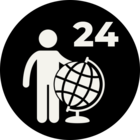Hi.
I've used RasterMosaicker before without problems, but now it gives me issues.
Another FME translation generates a folder of JPEG raster tiles, and I'm now attempting to join them together in a single raster mosaic. This fails, overlaying each tile on top of each other.
All the tiles are 2000x2000 pixels, and the resulting raster may easily be 15x that much. Is this a problem ?
I've checked both "Generate World File" and "Write EXIF tags" in the final JPEG writer in the original translation, but this doesn't seem to make it work.
Any insights into this issue will be appreciated.
Cheers


















